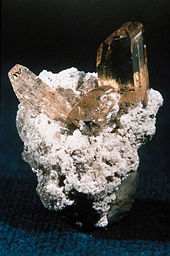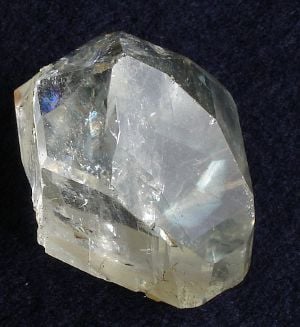Difference between revisions of "Topaz" - New World Encyclopedia
(imported latest version of article from Wikipedia) |
|||
| Line 1: | Line 1: | ||
| − | {{ | + | {{Claimed}}{{Images OK}} |
| − | |||
{{Infobox mineral | {{Infobox mineral | ||
| name = Topaz | | name = Topaz | ||
| Line 17: | Line 16: | ||
'''Topaz''' is a [[silicate mineral]] of [[aluminium]] and [[fluorine]] with the chemical formula Al<sub>2</sub>SiO<sub>4</sub>(F,OH)<sub>2</sub>. It crystallizes in the [[orthorhombic]] system and its [[crystal]]s are mostly prismatic terminated by pyramidal and other faces, the basal [[pinacoid]] often being present. It has an easy and perfect basal [[cleavage (crystal)|cleavage]], meaning that [[gemstone]]s or other fine specimens have to be handled with care to avoid developing cleavage flaws. The fracture is [[conchoidal fracture|conchoidal]] to uneven. Topaz has a [[Mohs scale of mineral hardness|hardness]] of 8, a [[specific gravity]] of 3.4-3.6, and a vitreous luster. Pure topaz is transparent but is usually tinted by impurities; typical topaz is wine or straw-[[yellow]]. They may also be [[white]], [[gray (color)|gray]], [[green]], [[blue]], [[pink]] or [[red]]dish-yellow and transparent or translucent. When heated, yellow topaz often becomes reddish-pink. It can also be [[Irradiation|irradiated]], turning the stone a light and distinctive shade of blue. A recent trend in jewelry is the manufacture of topaz specimens that display iridescent colors, by applying a thin layer of [[titanium oxide]] via [[physical vapor deposition]]. The most famous gemstone created by physical vapor deposition to date is "Mystic Fire Topaz". [http://www.azotic.us Azotic Coatings] patented the name "Mystic Fire Topaz" in 1998. | '''Topaz''' is a [[silicate mineral]] of [[aluminium]] and [[fluorine]] with the chemical formula Al<sub>2</sub>SiO<sub>4</sub>(F,OH)<sub>2</sub>. It crystallizes in the [[orthorhombic]] system and its [[crystal]]s are mostly prismatic terminated by pyramidal and other faces, the basal [[pinacoid]] often being present. It has an easy and perfect basal [[cleavage (crystal)|cleavage]], meaning that [[gemstone]]s or other fine specimens have to be handled with care to avoid developing cleavage flaws. The fracture is [[conchoidal fracture|conchoidal]] to uneven. Topaz has a [[Mohs scale of mineral hardness|hardness]] of 8, a [[specific gravity]] of 3.4-3.6, and a vitreous luster. Pure topaz is transparent but is usually tinted by impurities; typical topaz is wine or straw-[[yellow]]. They may also be [[white]], [[gray (color)|gray]], [[green]], [[blue]], [[pink]] or [[red]]dish-yellow and transparent or translucent. When heated, yellow topaz often becomes reddish-pink. It can also be [[Irradiation|irradiated]], turning the stone a light and distinctive shade of blue. A recent trend in jewelry is the manufacture of topaz specimens that display iridescent colors, by applying a thin layer of [[titanium oxide]] via [[physical vapor deposition]]. The most famous gemstone created by physical vapor deposition to date is "Mystic Fire Topaz". [http://www.azotic.us Azotic Coatings] patented the name "Mystic Fire Topaz" in 1998. | ||
| + | |||
| + | == Occurrence == | ||
Topaz is commonly associated with [[silicic]] igneous rocks of the [[granite]] and [[rhyolite]] type. It typically crystallizes in granitic [[pegmatites]] or in vapor cavities in rhyolite lava flows like those at Topaz Mountain in western Utah. It may be found with [[fluorite]] and [[cassiterite]]. It can be found in the [[Ural mountains|Ural]] and [[Ilmen mountains|Ilmen]] mountains, [[Afghanistan]], [[Czech Republic]], [[Germany]], [[Norway]], [[Pakistan]], [[Italy]], [[Sweden]], [[Japan]], [[Brazil]], [[Mexico]], and the [[United States]]. | Topaz is commonly associated with [[silicic]] igneous rocks of the [[granite]] and [[rhyolite]] type. It typically crystallizes in granitic [[pegmatites]] or in vapor cavities in rhyolite lava flows like those at Topaz Mountain in western Utah. It may be found with [[fluorite]] and [[cassiterite]]. It can be found in the [[Ural mountains|Ural]] and [[Ilmen mountains|Ilmen]] mountains, [[Afghanistan]], [[Czech Republic]], [[Germany]], [[Norway]], [[Pakistan]], [[Italy]], [[Sweden]], [[Japan]], [[Brazil]], [[Mexico]], and the [[United States]]. | ||
| Line 31: | Line 32: | ||
Yellow topaz is the traditional November [[birthstone]]. | Yellow topaz is the traditional November [[birthstone]]. | ||
| − | |||
[[Image:Topaz-2.jpg|thumb|Colorless topaz, Minas Gerais, Brazil]] | [[Image:Topaz-2.jpg|thumb|Colorless topaz, Minas Gerais, Brazil]] | ||
| + | == Notes == | ||
<div class="references-small"> | <div class="references-small"> | ||
| − | + | <references/> | |
</div> | </div> | ||
| + | |||
| + | == References == | ||
| + | |||
| + | * Hurlbut, Cornelius S., and Cornelis Klein. 1985. ''Manual of Mineralogy''. 20th ed. New York: John Wiley. ISBN 0-471-80580-7. | ||
| + | * Sofianides, Anna S., and George E. Harlow. 1997. ''Gems & Crystals''. London: Parkgate Books. ISBN 1-85585-391-4. | ||
| + | * Weinstein, Michael. 1967. ''The World of Jewel Stones''. New York: Sheridan House. ASIN: B000IN1RC4. | ||
== External links == | == External links == | ||
| − | |||
| + | * [http://www.gemstone.org/gem-by-gem/english/topaz.html Topaz] "Gem by Gem" series, International Colored Gemstone Association. Retrieved March 23, 2007. | ||
* [http://webmineral.com/data/Topaz.shtml Webmineral] | * [http://webmineral.com/data/Topaz.shtml Webmineral] | ||
* [http://www.mindat.org/show.php?id=3996&ld=1&pho= Mindat with location data] | * [http://www.mindat.org/show.php?id=3996&ld=1&pho= Mindat with location data] | ||
* [http://mineral.galleries.com/minerals/silicate/topaz/topaz.htm Mineral galleries] | * [http://mineral.galleries.com/minerals/silicate/topaz/topaz.htm Mineral galleries] | ||
| − | [[Category: | + | [[Category:Physical sciences]] |
| − | [[Category: | + | [[Category:Earth sciences]] |
| − | [[Category: | + | [[Category:Geology]] |
| + | [[Category:Minerals]] | ||
| − | + | {{credit|116841115}} | |
| − | |||
| − | |||
| − | |||
| − | |||
| − | |||
| − | |||
| − | |||
| − | |||
| − | |||
| − | |||
| − | |||
| − | |||
| − | |||
| − | |||
| − | |||
| − | |||
| − | |||
| − | |||
| − | |||
| − | |||
| − | |||
| − | |||
| − | |||
Revision as of 02:20, 24 March 2007
| Topaz | |
|---|---|
 an unfinished topaz crystal |
|
| General | |
| Category | Mineral |
| Chemical formula | Al2SiO4(F,OH)2 |
| Identification | |
| {{{molweight}}} | |
| Color | Clear (if no impurities); also see Varieties |
| Crystal system | orthorhombic |
| Fracture | conchoidal |
| Mohs Scale hardness | 8 |
| Luster | Vitreous/glossy |
| Specific gravity | 3.4-3.6 |
| {{{density}}} | |
Topaz is a silicate mineral of aluminium and fluorine with the chemical formula Al2SiO4(F,OH)2. It crystallizes in the orthorhombic system and its crystals are mostly prismatic terminated by pyramidal and other faces, the basal pinacoid often being present. It has an easy and perfect basal cleavage, meaning that gemstones or other fine specimens have to be handled with care to avoid developing cleavage flaws. The fracture is conchoidal to uneven. Topaz has a hardness of 8, a specific gravity of 3.4-3.6, and a vitreous luster. Pure topaz is transparent but is usually tinted by impurities; typical topaz is wine or straw-yellow. They may also be white, gray, green, blue, pink or reddish-yellow and transparent or translucent. When heated, yellow topaz often becomes reddish-pink. It can also be irradiated, turning the stone a light and distinctive shade of blue. A recent trend in jewelry is the manufacture of topaz specimens that display iridescent colors, by applying a thin layer of titanium oxide via physical vapor deposition. The most famous gemstone created by physical vapor deposition to date is "Mystic Fire Topaz". Azotic Coatings patented the name "Mystic Fire Topaz" in 1998.
Occurrence
Topaz is commonly associated with silicic igneous rocks of the granite and rhyolite type. It typically crystallizes in granitic pegmatites or in vapor cavities in rhyolite lava flows like those at Topaz Mountain in western Utah. It may be found with fluorite and cassiterite. It can be found in the Ural and Ilmen mountains, Afghanistan, Czech Republic, Germany, Norway, Pakistan, Italy, Sweden, Japan, Brazil, Mexico, and the United States.
The biggest topaz crystal ever found - named "El Dorado" - was found in Brazil in 1984. It weighs 6.2 kg and belongs to the British Royal Collection.
Etymology and historical and mythical usage
The name "topaz" is derived from the Greek topazos, "to seek ," which was the name of an island in the Red Sea that was difficult to find and from which a yellow stone (now believed to be a yellowish olivine) was mined in ancient times. In the Middle Ages the name topaz was used to refer to any yellow gemstone, but now the name is only properly applied to the silicate described above.
According to Rebbenu Bachya, the word "Leshem" in the verse Exodus 28:19 means "Topaz" and was the stone on the Ephod representing the tribe of Dan.
Yellow topaz is the traditional November birthstone.
Notes
ReferencesISBN links support NWE through referral fees
- Hurlbut, Cornelius S., and Cornelis Klein. 1985. Manual of Mineralogy. 20th ed. New York: John Wiley. ISBN 0-471-80580-7.
- Sofianides, Anna S., and George E. Harlow. 1997. Gems & Crystals. London: Parkgate Books. ISBN 1-85585-391-4.
- Weinstein, Michael. 1967. The World of Jewel Stones. New York: Sheridan House. ASIN: B000IN1RC4.
External links
- Topaz "Gem by Gem" series, International Colored Gemstone Association. Retrieved March 23, 2007.
- Webmineral
- Mindat with location data
- Mineral galleries
Credits
New World Encyclopedia writers and editors rewrote and completed the Wikipedia article in accordance with New World Encyclopedia standards. This article abides by terms of the Creative Commons CC-by-sa 3.0 License (CC-by-sa), which may be used and disseminated with proper attribution. Credit is due under the terms of this license that can reference both the New World Encyclopedia contributors and the selfless volunteer contributors of the Wikimedia Foundation. To cite this article click here for a list of acceptable citing formats.The history of earlier contributions by wikipedians is accessible to researchers here:
The history of this article since it was imported to New World Encyclopedia:
Note: Some restrictions may apply to use of individual images which are separately licensed.
